power steering CHEVROLET BLAZER 1995 2.G Owners Manual
[x] Cancel search | Manufacturer: CHEVROLET, Model Year: 1995, Model line: BLAZER, Model: CHEVROLET BLAZER 1995 2.GPages: 380, PDF Size: 20.04 MB
Page 161 of 380
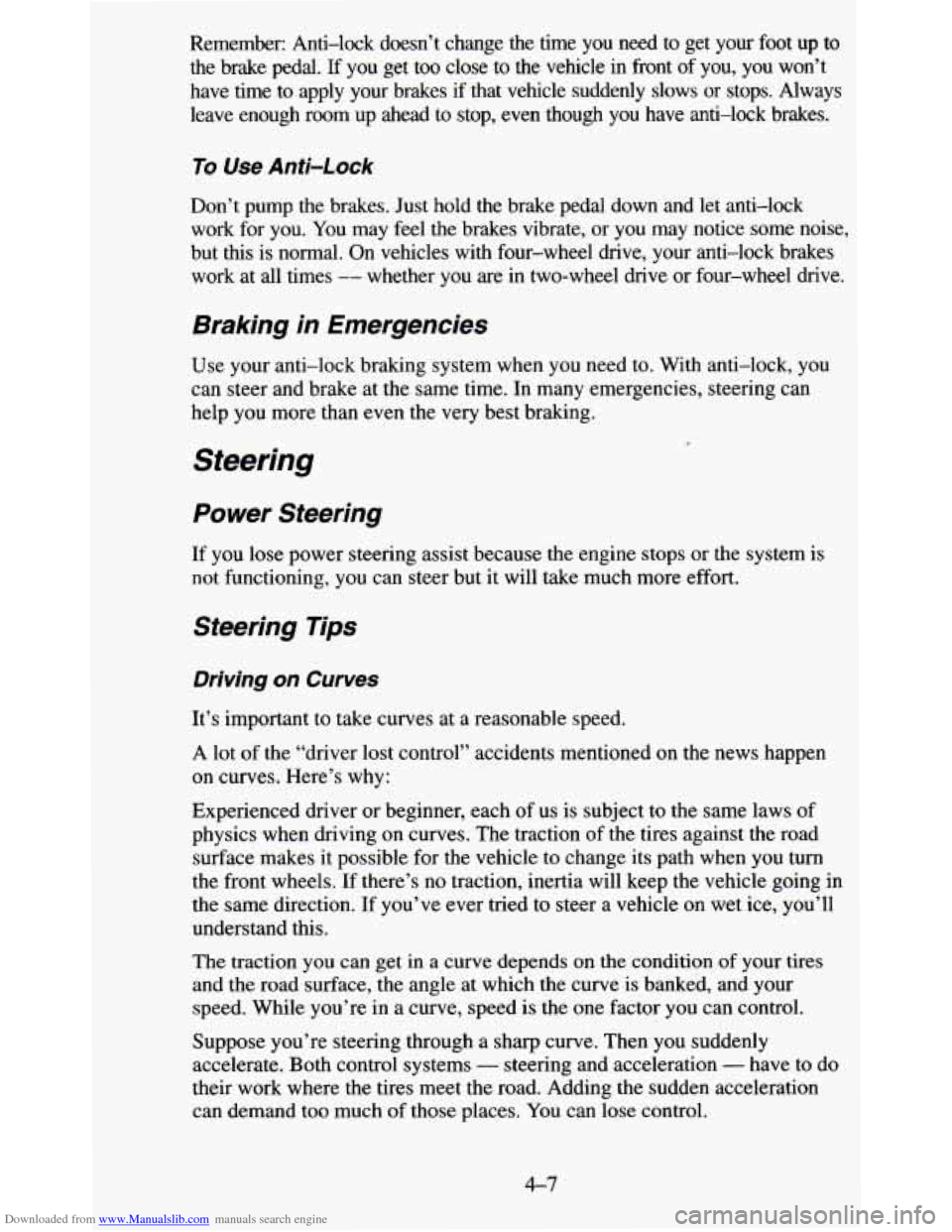
Downloaded from www.Manualslib.com manuals search engine Remember: Anti-lock doesn’t change the time you need to get \
your foot up to
the brake pedal. If you get too close to the vehicle in front of you, you won’t
have time to apply your brakes if that vehicle suddenly slows \
or stops. Always leave enough room up ahead to stop, even though you have anti\
-lock brakes.
To Use Anti-Lock
Don’t pump the brakes. Just hold the brake pedal down and \
let anti-lock work for you.
You may feel the brakes vibrate, or you may notice some noise,
but this is normal. On vehicles with four-wheel drive, your anti-lock brakes
work at all times
-- whether you are in two-wheel drive or four-wheel drive.
Braking in Emergencies
Use your anti-lock braking system when you need to. With anti-\
lock, you
can steer and brake at the same time. In many emergencies, steering can
help you more than even the very best braking.
Power Steering
If you lose power steering assist because the engine stops or the system is
not functioning, you can steer but it will take much more effort.
Steering lips
Driving on Curves
It’s important to take curves at a reasonable speed.
A lot
of the “driver lost control” accidents mentioned on the news \
happen
on curves. Here’s why:
Experienced driver or beginner, each of us is subject to the same laws of
physics when driving on curves. The traction
of the tires against the road
surface makes it possible
for the vehicle to change its path when you turn
the front wheels. If there’s no traction, inertia will keep the vehicle going in
the same direction.
If you’ve ever tried to steer a vehicle on wet ice, you’ll
understand this.
The traction you can get
in a curve depends on the condition of your tires
and
the road surface, the angle at which the curve is banked, and your
speed. While you’re in a curve, speed is the one factor you can control.
Suppose you’re steering through a sharp curve. Then you suddenly
accelerate. Both control systems
- steering and acceleration - have to do
their work where the tires meet the road. Adding the sudden acceleration
can demand too much
of those places. You can lose control.
4-7
Page 170 of 380
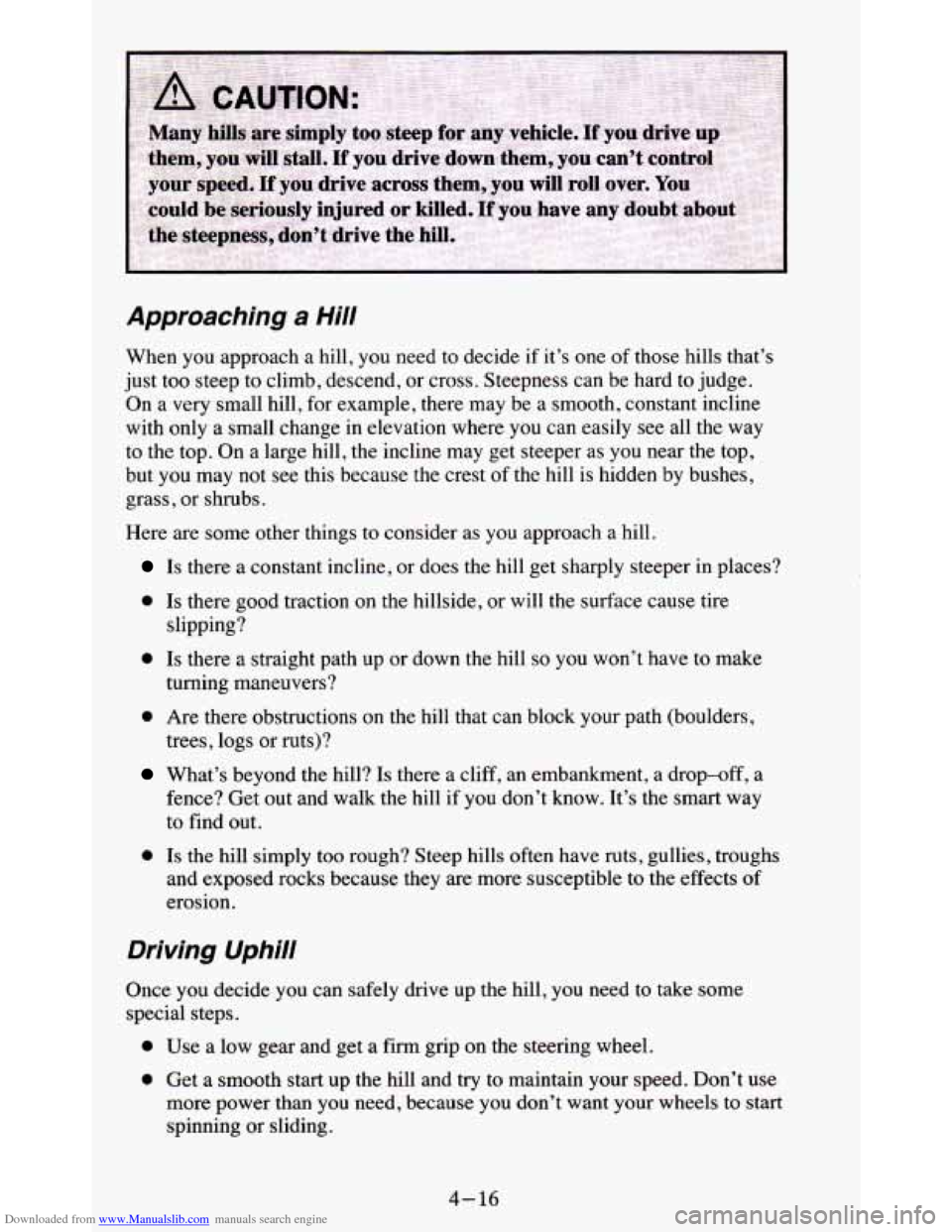
Downloaded from www.Manualslib.com manuals search engine Approaching a Hill
When you approach a hill, you need to decide if it’s one of those hills that’s
just too steep to climb, descend, or cross. Steepness can be hard to judge.
On a very small hill, for example, there may be a smooth, constant incline
with only
a small change in elevation where you can easily see all the way
to the top. On
a large hill, the incline may get steeper as you near the top,
but you may not see this because the crest of the hill is h\
idden by bushes,
grass, or shrubs.
Here are some other things to consider as you approach a hill.
Is there a constant incline, or does the hill get sharply steeper in places?
0 Is there good traction on the hillside, or will the surface cause tire
0 Is there a straight path up or down the hill so you won’t have to make
0 Are there obstructions on the hill that can block your path (boulders,
trees, logs or ruts)?
What’s beyond the hill? Is there a cliff, an embankment, a drop-off, a
fence? Get out and walk the hill if you don’t know. It’s the smart way
to find out.
slipping?
turning maneuvers?
0 Is the hill simply too rough? Steep hills often have ruts, gullies, troughs
and exposed rocks because they are more susceptible to the effects
of
erosion.
Driving Uphi//
Once you decide you can safely drive up the hill, you need to take some
special steps.
0 Use a low gear and get a firm grip on the steering wheel.
0 Get a smooth start up the hill and try to maintain your speed. Don’t use
more power than you need, because you don’t want your wheels
to start
spinning or sliding.
4- 16
Page 265 of 380
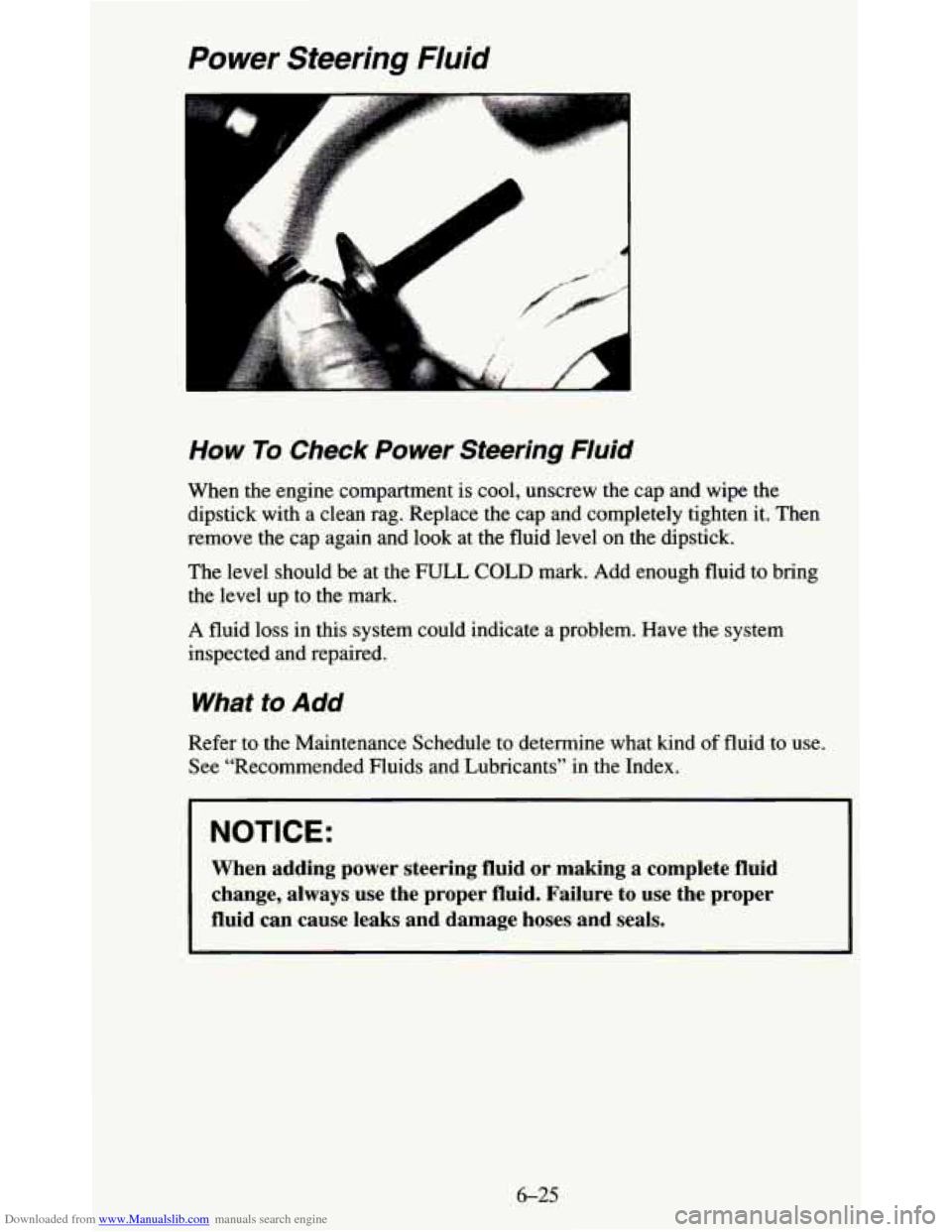
Downloaded from www.Manualslib.com manuals search engine Power Steering Fluid
How To Check Power Steering Fluid
When the engine compartment is cool, unscrew the cap and wipe the
dipstick with a clean rag. Replace the cap and completely tighten it. Then
remove the cap again and look at the fluid level on the dips\
tick.
The level should be at the
FULL COLD mark. Add enough fluid to bring
the level up to the mark.
A fluid loss in this system could indicate a problem. Have the system
inspected and repaired.
What to Add
Refer to the Maintenance Schedule to determine what kind of fluid to use.
See “Recommended Fluids and Lubricants” in the Index.
NOTICE:
When adding power steering fluid or making a complete fluid
change, always use the proper fluid. Failure to use the proper\
fluid can cause leaks and damage hoses and seals.
6-25
Page 350 of 380
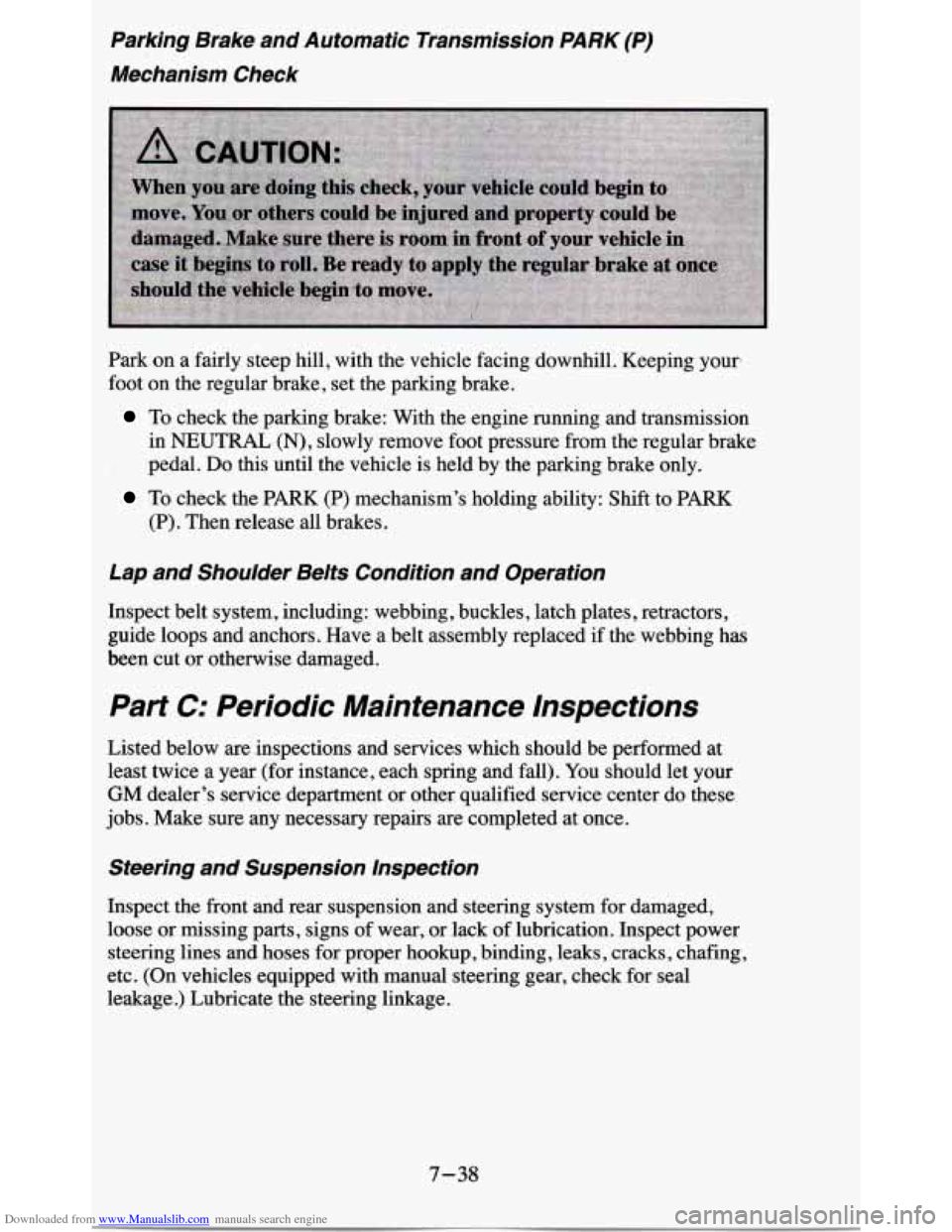
Downloaded from www.Manualslib.com manuals search engine Parking Brake and Automatic Transmission PARK (P)
Mechanism Check
Park on a fairfy steep hill, with the vehicle facing downhill. Keeping your
foot on the regular brake, set the parking brake.
To check the parking brake: With the engine running and transmission
in
NEUTRAL (N), slowly remove foot pressure from the regular brake
pedal.
Do this until the vehicle is held by the parking brake only.
To check the PARK (P) mechanism’s holding ability: Shift to PARK
(P). Then release all brakes.
Lap and Shoulder Belts Condition and Operation
Inspect belt system, including: webbing, buckles, latch plates, retractors,
guide loops and anchors. Have a belt assembly replaced if the webbing has
been cut or otherwise damaged.
Part C: Periodic Maintenance Inspections
Listed below are inspections and services which should be perfo\
rmed at
least twice a year (for instance, each spring and fall). You should let your
GM dealer’s service department or other qualified service center do these
jobs. Make sure any necessary repairs are completed at once.
Steering and Suspension Inspection
Inspect the front and rear suspension and steering system for damaged,
loose or missing parts, signs of wear, or lack of lubrication. Inspect power
steering lines
and hoses for proper hookup, binding, leaks, cracks, chafing,
etc. (On vehicles equipped with manual steering gear, check for seal
leakage
.) Lubricate the steering linkage.
7-38
Page 352 of 380
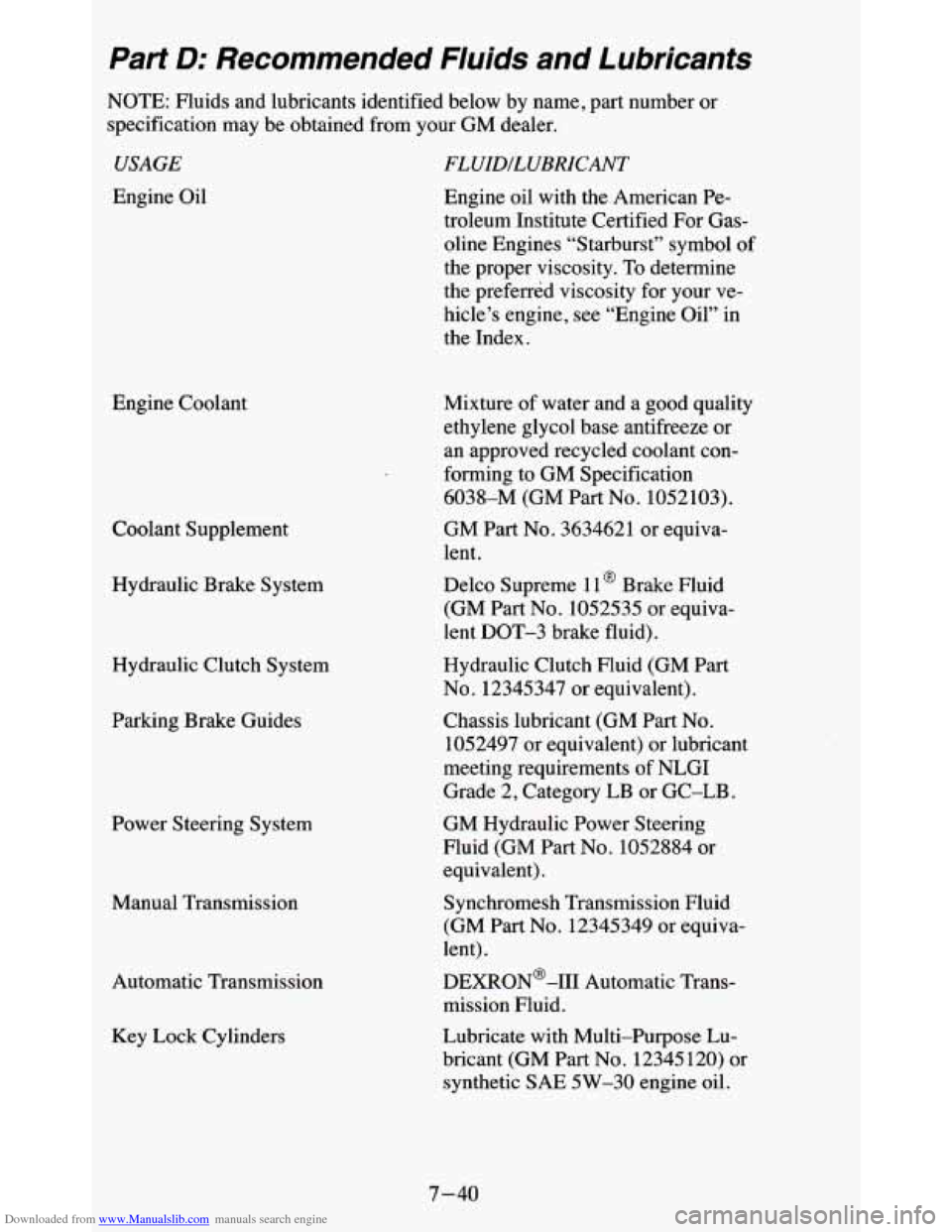
Downloaded from www.Manualslib.com manuals search engine Part D: Recommended Fluids and Lubricants
NOTE: Fluids and lubricants identified below by name, part number or
specification may be obtained from your GM dealer.
USAGE
Engine Oil
Engine Coolant
Coolant Supplement Hydraulic Brake System
Hydraulic Clutch System
Parking Brake Guides
Power Steering System
Manual Transmission
Automatic Transmission
Key Lock Cylinders
FLUIDILUBRICANT
Engine oil with the American Pe-
troleum Institute Certified For Gas-
oline Engines “Starburst” symbol
of
the proper viscosity. To determine
the preferred viscosity for your ve-
hicle’s engine, see “Engine Oil” in
the Index.
Mixture of water and a good quality
ethylene glycol base antifreeze or
an approved recycled coolant con-
forming to GM Specification
6038-M (GM Part
No. 1052103).
GM Part No. 3634621 or equiva-
lent.
Delco Supreme 11
@ Brake Fluid
(GM Part No. 1052535 or equiva-
lent DOT-3 brake fluid).
Hydraulic Clutch Fluid (GM Part
No. 12345347 or equivalent).
Chassis lubricant (GM Part
No.
1052497 or equivalent) or lubricant
meeting requirements
of NLGI
Grade 2, Category
LB or GC-LB .
GM Hydraulic Power Steering
Fluid (GM Part
No. 1052884 or
equivalent).
Synchromesh Transmission Fluid
(GM Part
No. 12345349 or equiva-
lent).
DEXRON@-I11 Automatic Trans-
mission Fluid.
Lubricate with Multi-Purpose Lu-
bricant (GM Part
No. 12345 120) or
synthetic
SAE 5W-30 engine oil.
7-40
Page 374 of 380
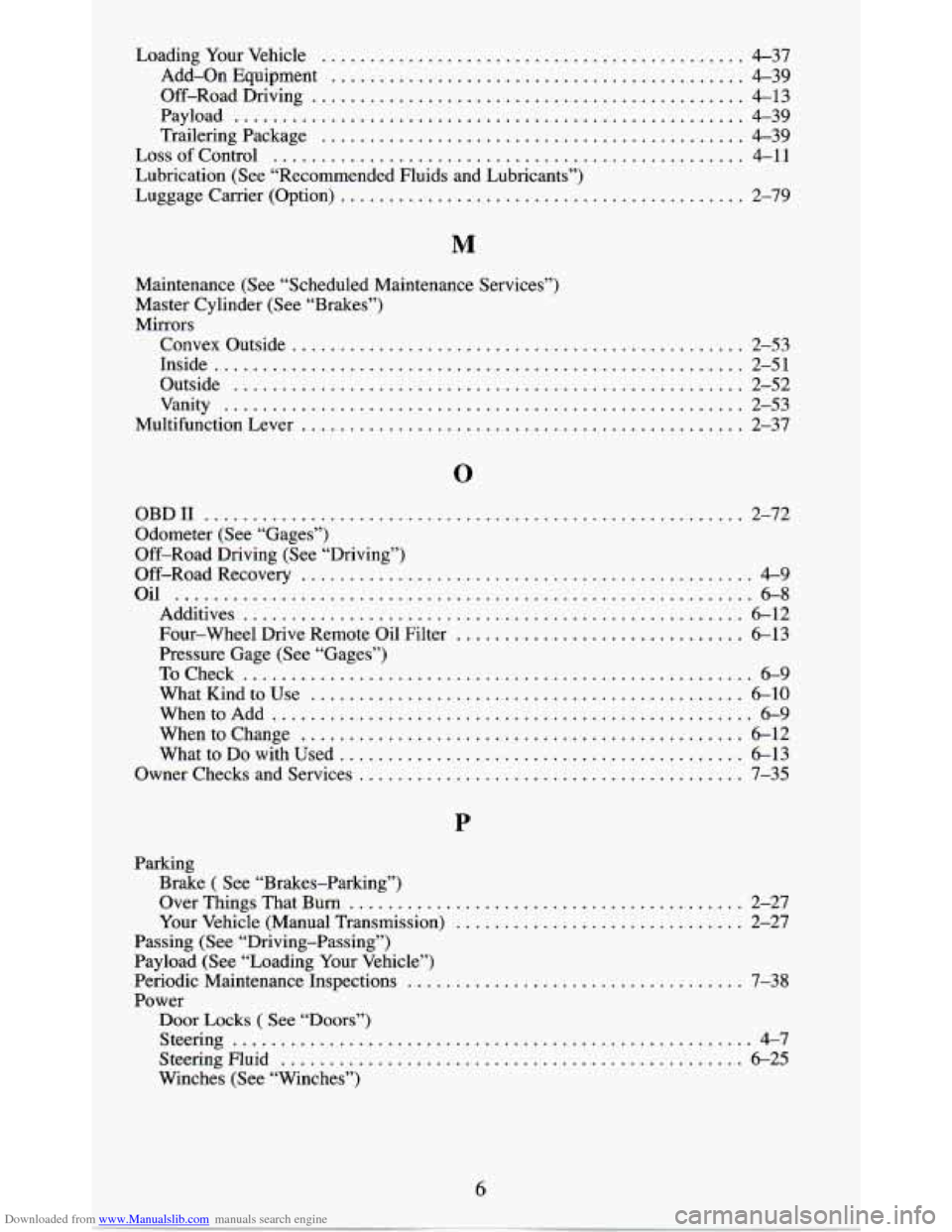
Downloaded from www.Manualslib.com manuals search engine LoadingYourVehicle ............................................ 4-37
Add-on Equipment ........................................... 4-39
Off-RoadDriving ............................................. 4-13
Payload ..................................................... 4-39
Trailering Package ............................................ 4-39
Loss of Control ................................................. 4-11
Lubrication (See “Recommended Fluids and Lubricants”)
Luggage Carrier (Option)
.......................................... 2-79
M
Maintenance (See “Scheduled Maintenance Services”)
Master Cylinder (See “Brakes”)
Mirrors
ConvexOutside
............................................... 2-53
Inside ....................................................... 2-51
Outside ..................................................... 2-52
Vanity ...................................................... 2-53
MultifunctionLever .............................................. 2-37
OBDII ........................................................ 2-72
Odometer (See “Gages”)
Off-Road Driving (See “Driving”)
Off-Road Recovery
............................................... 4-9
Oil ............................................................ 6-8
Additives .................................................... 6-12
Four-wheel Drive Remote Oil Filter .............................. 6-13
Pressure Gage (See “Gages”)
ToCheck
..................................................... 6-9
WhatKindtoUse ............................................. 6-10
WhentoAdd .................................................. 6-9
Whentochange .............................................. 6-12
What to Do with Used .......................................... 6-13
OwnerChecksandServices ........................................ 7-35
P
Parking
Brake
( See “Brakes-Parking”)
OverThingsThatBurn
......................................... 2-27
Your Vehicle (Manual Transmission) .............................. 2-27
Passing (See “Driving-Passing”)
Payload (See “Loading Your Vehicle”)
Periodic Maintenance Inspections
................................... 7-38
Power
Door Locks
( See “Doors”)
Steering ...................................................... 4-7
SteeringFluid ................................................ 6-25
Winches (See “Winches”)
6
Page 376 of 380

Downloaded from www.Manualslib.com manuals search engine Seats ...........................................................
Controls ......................................................
Easy Entry Seat (2-Door Models) .................................
Front Seatback Latches (2-Door Models) ...........................
Head Restraints ................................................
Manual Front Seat (Easy Entry) ...................................
Manual Front Seat (Except Easy Entry) .............................
Power Driver’s Seat ............................................
Power Lumbar Adjustment .......................................
RearFoldingSeat ..............................................
Reclining Front Seatbacks .......................................
SeatbackLatches ...............................................
Bulletins .....................................................
Service
Doing
Your Own Service Work ...................................
Parts Identification Label ....................................... 6-60
Publications ................................................... 8-8
Replacement Parts and Filter Recommendations ...................... 6-70
Service Engine Soon Light (See “Lights”)
Shift Indicator Light (See “Lights”)
Shifting Into Park (P)
............................................. 2-25
Speedometer and Odometer (See “Gages”)
StartingYourEngine
............................................. 2-16
Steering
........................................................ 4-7
In Emergencies ....................................... -1 ....... 4-8
Tips ......................................................... 4-7
Storage Compartments
............................................ 2-56
Coinholder
.................................................. 2-56
Sunvisors
..................................................... 2-53
Supplemental Inflatable Restraint System (SIR)
........................ 1-17
Adding Equipment to Your Air Bag-Equipped Vehicle
................ 1-21
How the Air Bag System Works .................................. 1-18
Servicing Your Air Bag-Equipped Vehicle
......................... 1-21
1-1
1-1
1-6
1-5
1-6
1-2
1-1
1-3
1-3
1-7
14
1-5
8-8
6-2
T
Tachometer (See “Gages”)
Temperature Display
............................................. 2-59
Theft
.......................................................... 2-13
Thermostat
..................................................... 6-24
Tilt Wheel (Option)
.............................................. 2-36
Tires
.......................................................... 6-41
Balancing (See “Wheel Alignment and Tire Balance”)
Chains
...................................................... 6-48
Flat (See “Changing a Flat Tire”) Inspection and Rotation-
........................................ 6-43
New ........................................................ 6-44
Pressure ..................................................... 6-41
Spare (See “Spare Tire”)
Underbodycarrier
............................................ 5-25
Uniform Tire Quality Grading ................................... 6-45
TorqueLock .................................................... 2-26
Top
Strap (See “Safety Belts-Child Restraints”)
8